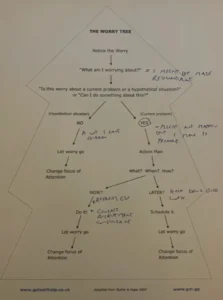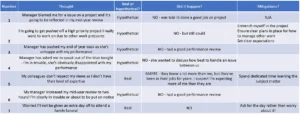Lessons from 15 years of working with (and not against) anxiety
During my final year exams at university, I was hit by an overwhelming wave of anxiety. My thoughts spiraled uncontrollably. What if I fail my exams? Then I’ll never get a good job. I’ll have spent all this time, effort, and money for nothing. I’ll never be successful, and never have a life I can be proud of.
I woke up every morning and was physically sick. During the day I couldn’t eat. I would go to bed every night shaking uncontrollably. It got to the point that the university doctor prescribed me Valium.
Yet the reality was, my grades from the previous years were good enough that even if I didn’t turn up to my exams I would still pass.
I have had to accept that I have two paradoxical personality traits. I am a driven, self-demanding, and ambitious person. I am also a highly anxious person with a high fear of professional failure.
15 years on, I’ve gone back to school to get an MBA, I’ve held high profile roles in both the public and private sector, I’ve managed multi-million-pound portfolios, and I’ve built and led teams of 20 people plus.
Along the way (and with a lot of help from my loving wife and a great therapist — not the same person) I’ve realized that you can build a good career, and be a good leader; even when anxiety is part of who you are.
Over the years I have identified some practices that help me cope when I start to feel my anxious brain turn on me. These are based on my own experience over the last 15 years of my working life; so while they are not guaranteed to work for you, I hope they will at least give you a starting point for wrangling your own anxiety.
You can’t get rid of anxiety, as much as you might want to
When I first started seeing a therapist, I described my anxiety as a cancer I wanted to cut out — something I hated about myself. And don’t get me wrong, I would still rather have a life without being plagued by prolonged periods of worry.
But over time I’ve come to accept that at least for me, worry isn’t something I’m going to find a cure for. It is, however, something I can minimize.
This really was the starting point for me, accepting that anxiety was something I was going to have to learn to live with.
You have to face your anxious thoughts to reduce their power
There are still many days where I ‘numb out’ to reduce my feelings of anxiety, often by watching TV. While this always provides a temporary feeling of relief, I know it doesn’t solve the problem.
I have far better results when I face my anxious thoughts head-on. I won’t lie, this isn’t fun, and it’s a lot easier to get a dopamine fix by watching tele, but facing my worries seems to create a form of exposure therapy.
Let me explain.
I know that my anxiety is primarily related to professional failure, so when I put myself into new situations where I genuinely could fail (like starting a new job), I feel anxious. The key for me is remembering that the things I’m worried about are things that could happen, not things that definitely will happen.
Still, these hypothetical worries cause me significant angst.
To counter this, rather than run away from my thoughts, I try to sit with these worries and work through what the worst thing that could happen is. Often the worst thing is I could lose my job. This would be humiliating and uncomfortable, but not the end of the world. I have some savings. I would eventually dust myself off and find a new job. I could handle it.
This practice helps take the power out of my worries as I realize I’m stronger than I think I am, and the things I’m worrying about are not as catastrophic as my mind is telling me they are.
Keep a list of your worries
A concept my therapist introduced me to that I find extremely helpful is the practice of keeping a worry list. Throughout the weeks, I capture all the things that I’m worried about. Then at the end of each day I review my list and categorize them into two:
- Real event worries: actual problems that are affecting me right now, which I can solve through action. If I can take action now to immediately resolve a worry, I do. If not, I make a schedule for when I can and do my best to put the worry out of my mind.
- Hypothetical worries: what if thoughts about things that have not yet happened, but might happen in the future. For these types of worries, I assess the likelihood of them occurring and put plans in place to mitigate my worries, if possible. For things that are out of my control, I try my best to put them aside.
Here’s an example below, from when I was going through a redundancy process :

When analyzing your worries like this, it’s helpful to remember that worry is the body’s natural response to perceived threats. It’s triggered by your mind’s desire to avoid a threat to your well-being. It’s designed to feel bad — your heart races, you feel sick to your stomach, your mind swirls — and you take notice that you’re in a vulnerable situation. There’s useful data here.
The challenge is to understand which of your worries are real, which are hypothetical, and what you can practically do about them. Uncontrolled worrying simply fuels anxiety. But capturing your worries and making a plan to deal with them lets you take back control.
Track your worries
Another useful practice is to track your worries. You can do this with a pen and paper, or numerous apps can help you do this. Here’s a screenshot of how I track my worries on my phone.

In October 2022, I recorded seven work worries. And of those seven can you guess how many of them have actually happened?
None of them.

Sure, some of them might still come true, but that doesn’t mean they definitely will. And I can put plans in place to minimize the chances of them occurring.
What’s really interesting is on any given month, approximately 90% of the worries I capture don’t come true. Doing this exercise each month weakens the power anxiety holds over me, as I know (and the data shows) that I tend to over-worry and the majority of my worries, while possible, are not probable.
By challenging my anxiety with compounding, objective evidence every month, I find my anxiety levels decrease.
Understand what you’re worried about by free writing
Despite having tools in place to help me manage my anxiety, there are days when I wake up exhausted as I’ve been worrying in my sleep, but I have no idea what my brain is really worried about. On these mornings, free writing is the best thing I’ve found to help me reduce anxiety.
This simply involves writing down your thoughts, whatever they may be, without censoring or editing them. The purpose is to try and understand what you are actually worried about.
A helpful prompt for getting your thoughts down on paper is to structure this as a free-flowing conversation with yourself. Here is an example from a time when I was going through a corporate restructuring, and it looked like a peer who didn’t like me very much could become my boss:

Once I’ve identified what I’m worrying about, I can determine if my worry is real or hypothetical, how likely it is to happen, and put a plan in place to minimize any potential risks.
Leaders set the tone so be authentic
So far everything I’ve mentioned is about managing your anxiety on an individual level.
But as I’ve advanced in my career and taken on more leadership positions, I’ve realized that one of the most dangerous aspects of anxiety is that it can be contagious.
Leaders set the tone, and if you present at work as anxious your team can easily misinterpret why you are anxious (i.e. “is the company in trouble?” “Should I look for a new job?”).
If you’re going through a period of high anxiety, remember — your team doesn’t need you to be invincible, but they do need you to be authentic.
This doesn’t mean you need to share your most intimate worries; just share the state you’re in so they are aware of what’s going on with you. This starts with you, as a leader acting to end the stigma of mental health at work — bring it into the discussion.
You don’t need to overshare, but if you can get comfortable sharing your own struggles, people will see you as authentic, empathetic, and possibly even someone they can admire.
Everyone has mental health struggles at some point in their life. Show your team it is possible to take care of your mental well-being while continuing to show up as a strong, competent, and present leader.
Model self-care and set good boundaries
When you live with anxiety, it’s essential you maintain your cornerstone habits — regular exercise, a good sleep routine, and a healthy work/life balance.
If you’re in a position of leadership, you have a responsibility to lead by example. If your team sees you practicing healthy behavior — taking time off to rest, socialize, and exercise; they will feel empowered to do the same. If they see you working long hours, never taking breaks, and letting your physical and mental health slip, they will do the same.
At the end of the day, how a manager acts sets the culture of the team. Don’t feed a culture of overworking, take breaks, and demonstrate balance. And prioritize your physical and mental health so you can work well.
Build a support crew
The last thing I would say is that building a support network to help manage your anxiety, and navigate the inevitable setbacks life throws at you, is a strategy for long-term success as a leader.
As an anxious person, you need to accept that your thoughts can sometimes make you an unreliable narrator of your own performance. You need to develop a network of ‘safe people’ you can check these thoughts with. This can be a therapist, a loved one (I’d recommend both), friends, family peers, you name it.
Your support network can offer you clarity of thought in times when you’re not easily able to do this for yourself.
This network should not however include a new boss, or members of a team you have just started leading. If you are frequently expressing concern or need constant validation at the beginning of your relationship with them — they make misinterpret this as you doubting your ability to lead.
Parting thoughts
In writing this, I don’t claim to have all the answers. Anxiety is something I’ll be living with all my life and will no doubt change evolve and grow with me over time.
But if like me, you want to challenge yourself, push outside your comfort zone and not let anxiety limit you, I hope this offers you a blueprint for how you can work with, not against, anxiety.
Our culture tells us that people that suffer from anxiety and depression are fragile, can’t succeed, and should settle for a small life. If you take nothing else from this article, please take away this one thought:





